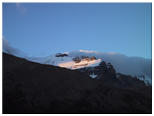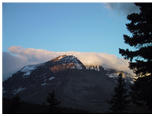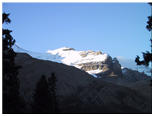



The morning briefing...
The trailhead for where we are going today has very limited parking, so we carpool. Seven of us go on a truck. This is a great place to go riding around on the back of a pickup truck.
We see the Sno-Coach base from all angles.
The sunlight has almost reached the area where the Sno-Coach passengers get to walk around on the ice.
Today's training area is in sight. Look at the first picture and try to estimate the scale for a moment. We will later be right at the icefall.
Crampons on, annoyingly a fair way short of where the ice begins. Walking on loose rock with crampons is not fun. Also it wears down the points.
Safely roped, we make our way up the glacier. This one has far more crevasses than the Athabasca Glacier below.
At a handy trench, we practice crevasse rescue. The more advanced group on the other side gets to haul real people out of the trench (not dangerous, it is only about 8ft deep). Our instructor only lets us haul out a dummy load of three backpacks. Also he watches our every step and does not allow me to go closer than 2m to the edge.
After we have each practiced all the roles in the Crevasse rescue procedure,
and can actually set up the complex network of gear without help from the
instructor, we rope up again and march up toward the icefall, where they
will demonstrate ice climbing technique. Now look at the first picture
large. See the dark speck just to the right of the instructor? That's
a person. This place is
The chief instructor has set up a belay climb that looks steep enough. But our instructor sets up one that includes an overhang.
When my turn comes, only one proper ice tool is handy, so a regular ice axe has to do for the other hand. With these further handicaps I can't get to the top, I get stuck on the overhang (or rather, unstuck: Eventually I fall off into the rope).
The ice climbing practice concludes day 2. We hike back out, again unroped, over the same crevasse-ridden terrain that we came up over. This is strange considering how carefully the instructors watch for our safety all the other time. We see the Sno-Coach operation in full sunlight.
Some other group is practicing the same stuff on the main glacier that we were doing yesterday.
In the campground we are briefed for the ascent the next day. We have to be at the trailhead and ready to march at 4:30am. Andrew says this will mean getting up at 2am.
They caution us that the mountain is "not democratic" - that if you can't measure up tomorrow you won't be able to do the summit. That we must be back at the cars by 2:30pm (10 hours - the icefields guide says that this climb takes "experienced climbers" between 10 and 15 hours).
They make us give back the helmets and the webbing. We won't be needing them. Andrew and I find this odd, because the webbing is an integral part of the crevasse rescue mechanism. Don't worry about it, they say, there will be enough pros along to take care of that.
I have a chat with the instructors. I'm a little concerned because I'm usually a little slower than others on hikes, and I'm not acclimatized to 10,000 feet. I want to be sure to do the summit, which is very important to me.